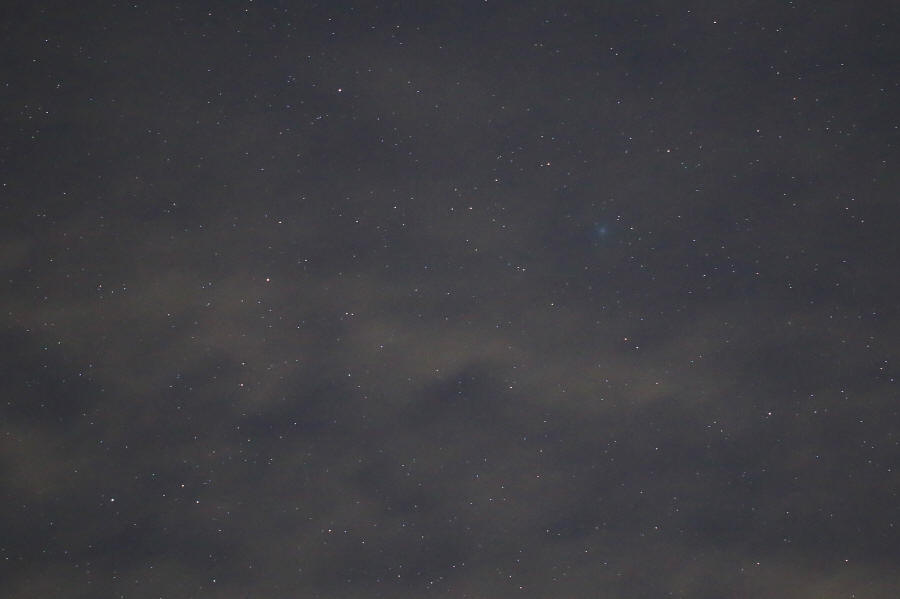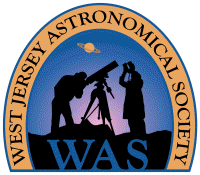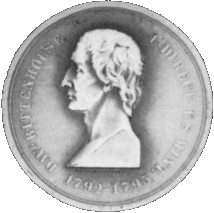Mercury Update
December 2018
Mercury has seven elongations in 2018. The initial sighting for each of these is tabulated below:
Sequence
Initial
Sighting Date
(2017/18)
Observing
Location
Greatest Elongation
(2018)
#1
January 1, western
(morning)
#2
March 15, eastern
(evening)
#3
April 29, western
(morning)
#4
July 12, eastern
(evening)
#5
August 26, western
(morning)
#6
November 6, eastern
(evening)
#7
December 24, 6:10 am EST
Swede Run, Moorestown, NJ
February 26, 5:56 pm EST
Baseball Fields, Maple Shade, NJ
April 22, 5:26 am EDT
Old Mart Site, Pennsauken, NJ
June 14, 8:41 pm EDT
Swede Run, Moorestown, NJ
August 24, 5:10 am EDT
Swede Run, Moorestown, NJ
October 13, 6:41 pm EDT
Swede Run, Moorestown, NJ
December 4, 6:20 am EST
Swede Run, Moorestown, NJ
December 15, western
(morning)
Click here for the sighting details of each elongation this year. The current sighting streak is now 51 elongations in a row, starting in January 2011, which includes eight complete calendar years of six or seven elongations. The years 2011, 2015 and 2018 each had seven (7) elongations, while 2012, 2013, 2014, 2016 and 2017 each had six (6). Click here for sightings from last year's elongations.
Comet 46P/Wirtanen
November 29, 2018
This snapshot of comet 46P/Wirtanen was captured on November 29, 2018, from Carranza Field in Wharton State Forest, NJ. It was taken at 9:23 pm EST with a Canon 6D digital SLR camera and a Canon 100 mm f/2.8L macro lens on a fixed tripod. It was exposed 4 seconds at f/2.8, ISO 6400, 3600 K white balance. It was cropped to about 60% of the original dimensions giving a field 12.6° wide x 8.4° high. Mouseover for labels.
At the time, 46P was close to 29° altitude in the southwest corner of the constellation Cetus, near the borders with Eridanus to the east and Fornax to the south. Overhead, there was a considerable cover of thin clouds, as seen in the picture. Despite the clouds, the comet was easily visible in 15x56 binoculars, but there wasn't a hint of it with unaided eyes. On the way home, I stopped at Swede Run in suburban Moorestown, NJ, and at 10:40 pm, I was barely able to detect 46P with the 15x56s, the reduced visibility being due to greater suburban light pollution and a little more cloud cover. Here's a light curve and recent observations of 46P/Wirtanen at COBS (Comet OBServation Database).
Update: On December 3, I was able to see 46P in Cetus with 15x56 binoculars from my suburban, light-polluted backyard, although it was at the limit of detectability. On December 4, I went to Carranza Field in Wharton State Forest, NJ, and easily saw 46P with the 15x56s, now in Eridanus; however, I was not able to see it with unaided eyes. In my 12.5-inch reflector, the coma was large with low surface brightness surrounding a brighter core and it seemed to have a slight greenish color. No tail was visible, but movement was clearly detected. I also was finally able to spot comet 38P/Stephan-Oterma with the 12.5-inch, a dim fuzz spot in Cancer, about 7° east-northeast of Pollux.
Asteroid (3) Juno
November 22, 2018
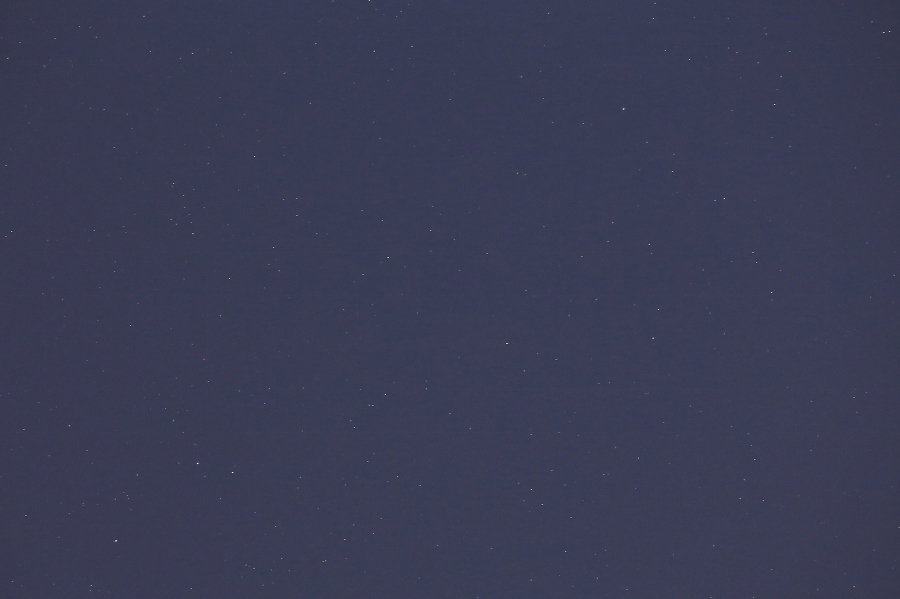
The main belt asteroid, or minor planet, (3) Juno, was at opposition on November 17, 2018, reaching a relatively bright magnitude 7.4 in the constellation Eridanus. This image of it was captured on November 22, 2018, at 12:09 am EST from my backyard in Maple Shade, NJ, with a nearly-full Moon (98.4% illuminated) just 20° away. Taken with a Canon 6D digital SLR camera and a Canon 200 mm f/2.8L lens on a fixed tripod. It was exposed 2 seconds at f/4, ISO 2000. Little processing was applied, but it was cropped to about 90% of the original dimensions providing a field nominally 9.2° wide x 6.2° high. Mouseover for labels.
Juno was initially spotted for this apparition a day earlier, November 20, 2018, about 10 pm, from Carranza Field in Wharton State Forest, NJ. It was initially seen with 15x56 binoculars and then confirmed with an 85 mm spotting scope at 27 to 60x. I initially picked up Beid and Keid (Omicron 1 & 2 Eri), followed a line from them about 6° to 32 Eri, then moved southwest past a flattened triangle of eighth-magnitude stars to a pair of seventh-magnitude "stars." On 20.9-Nov, Juno was 10 arc minutes northeast of the star HD 24107 and on 22.0-Nov (about 26 hours later) it was about 6 arc minutes west of that star. In the 15x56s, the movement was obvious (I didn't get the 85 mm scope out on 22-Nov, instead I took this snapshot). I was out back for another look on 22-Nov under a full Moon, picking Juno up at 10:25 pm (22.9-Nov) with the 15x56s. It had moved noticeably since the previous midnight, a total of about 25 arc minutes (almost a moon diameter) retrograde since the initial sighting on 20-Nov. The positions on the first and third nights, 20.9 and 22.9 November, have been added to the label overlay.
Antares Rocket Launch
November 17, 2018
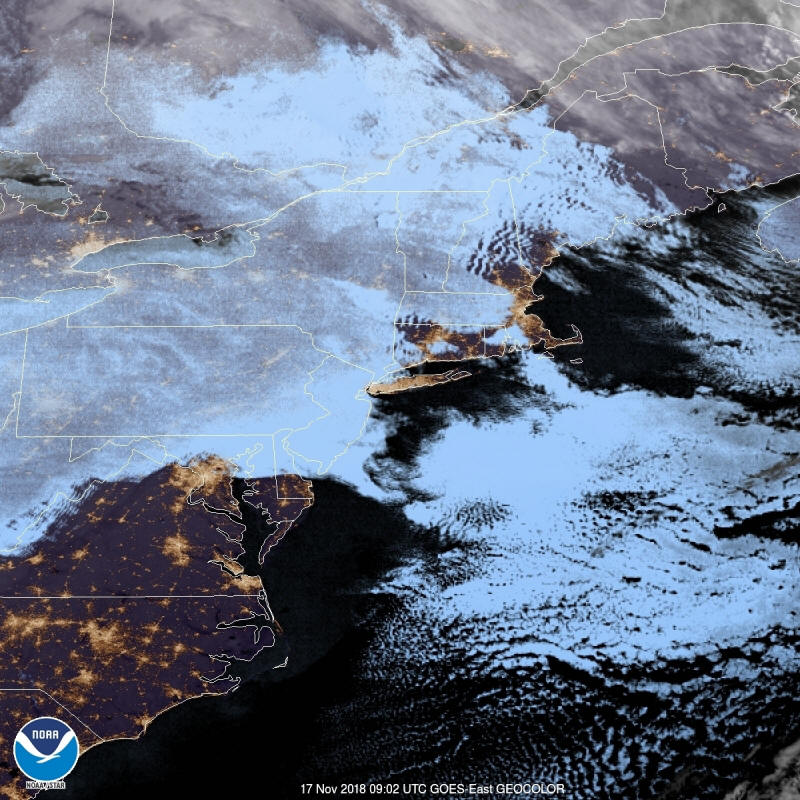
This image is the GOES-East regional view at 4:02 am EST on November 17, 2018, one minute after the launch from Wallops Island, Virginia, of an Antares rocket carrying a Cygnus cargo freighter to the International Space Station. It shows clear skies at Wallops, while New Jersey is blanketed in clouds, precluding any chance to see the ascending rocket from the Philadelphia area or the NJ Pines. There might have been a narrow gap between the horizon and the cloud deck looking south from East Point, NJ, but it wasn't worth an hour's drive each way to find out.
Comet Sightings
November 2018
I don't have any pictures yet, but I did manage to spot comet 46P/Wirtanen on Wednesday night, October 30, 2018, between 10:45 and 11:00 pm EDT from Carranza Field in Wharton State Forest, NJ. 46P is currently around ninth magnitude, but it is expected to reach naked-eye visibility in mid-December, 2018, when it's at both perihelion and a close perigee only days apart (December 12 and 16 respectively). As of the end of October and the beginning of November 2018, 46P is not well positioned for observers at mid-northern latitudes with a declination of 33°S, but it's southerly direction of movement bottoms out on November 3, ≈11 pm EDT (Nov 4, ≈03:00 UT) and then it will be heading north for it's hopefully bright, mid-December encounter, well placed for us at 40°N in the constellation Taurus. 46P was spotted again, with less difficulty, from Atsion on November 10, 2018, with the 12.5-inch. While at Atsion on November 10, I also had a nice view of comet 64P/Swift-Gehrels in the 12.5-inch.
The following morning, November 11, 2018, I went to Carranza Field in Wharton State Forest and was able to spot recently-discovered comet C/2018 V1 (Machholz-Fujikowa-Iwamoto) with 15x56 binoculars near Porrima (Gamma Vir), and then I confirmed it with my 85 mm spotting scope. The next morning, November 12, I went to Swede Run in suburban Moorestown, NJ. I could not see C/2018 V1 with the 15x56 binoculars, but it was seen in the 85 mm scope.
Because it was clear on November 20, 2018, I went back to Carranza despite a nearly-full Moon for another try at 46P/Wirtanen, and also an initial stab at 38P/Stephan-Oterma, using 15x56 binoculars and the 85 mm spotting scope. I was able to find the respective field stars for each comet, but alas, no sign of their diaphanous comas in the moonlit sky. I went to Swede Run the following morning, November 21, 2018, to look for C/2018 V1 (M-F-I). The Moon had set, but the low altitude, less-than-ideal transparency and suburban sky glow precluded seeing it.
Venus Sightings
October 2018
The planet Venus will be at geocentric inferior conjunction with the Sun, 6.26° south of it, on Friday, October 26, 2018, at 14:16 UT1 (10:16 am EDT). It will be 61.3" diameter and 0.6% illuminated. In anticipation of spotting Venus in the daytime at the moment of inferior conjunction, weather permitting, I'd been "practicing" looking for it on clear days this month, mostly with my 15x56 binoculars, but also with my 85 mm spotting scope (capable of 27 to 60x) in the final days before October 26. The sightings are tabulated below, the times being when initially spotted:
Date
(2018), Time
(EDT)
Observing
Location
Diam.
Illum. Elong.
51.6"
11.0% 27.1°
53.7"
8.6% 24.0°
55.3"
6.9% 21.6°
58.4"
3.5% 15.5°
60.6"
1.2% 9.2°
Backyard, Maple Shade, NJ
61.1"
0.8% 7.3°
Front Yard, Maple Shade, NJ
61.2"
0.6% 6.6°
61.3"
0.6% 6.3°
61.0"
1.1% 8.6°
Optics
October 07, 6:42 pm
15x56
Swede Run, Moorestown, NJ
October 10, 3:00 pm
15x56
Backyard, Maple Shade, NJ
October 12, 5:43 pm
15x56
Atsion, Wharton SF, NJ
October 17, 1:35 pm
15x56
Backyard, Maple Shade, NJ
October 22, 2:19 pm
15x56
Front Yard, Maple Shade, NJ
October 24, 10:10 am
October 24, 11:55 am
15x56
85 mm
Backyard, Maple Shade, NJ
October 25, 10:42 am
October 25, 12:35 pm
15x56
85 mm
Backyard, Maple Shade, NJ
October 26, 10:16 am
n/a
Cloudy
in Maple Shade, NJ
October 30, 1:39 pm
15x56
Backyard, Maple Shade, NJ
Diam. = Diameter, Illum. = Illumination, Elong. = Elongation* (for Venus in each case)
* As used here, the direct distance from Venus to the Sun measured with SkyTools (center-to-center) rather than the difference in ecliptic longitude. Diameter and Illumination are from the U.S. Naval Observatory, either online or via their MICA software.
Note that the sighting on October 7 was actually 9 minutes after sunset, so it's technically a nighttime sighting. The appearance on October 7 was like a wiggling, thick orange banana due to atmospheric absorption and distortion since Venus was only 3° altitude at the time. The rest of the sightings were higher in a blue sky and showed a sublime, silvery crescent, but in each case, the crescent looked wider than the illuminated percentage provided by the USNO would suggest. This is due to the phenomenon of irradiation. In addition, near the sun, forward scattering causes seed tufts (pappi; singular, pappus) to shine brightly as they blow by the sun, confusing the view. They were first noticed (for this conjunction) as a mild annoyance on October 22, and on October 24, were becoming annoying, perhaps because it was windy. I have not been able to see Venus in the daytime with my unaided, aging eyes.
On October 24, I went back out with my 85 mm spotting scope for another look and picked up Venus at 11:55 am EDT using the minimum magnification, 27x, then immediately increased it to the maximum, 60x. I followed it until 12:10 pm. The crescent looked relatively thinner than it did in the binoculars at 15x (less irradiation at the higher power?). The bright part of the thin crescent appeared to extend at least 180° around the circumference, and at moments of steady seeing and no wind jiggle, a vague rim of illumination seemed to wrap the entire circumference on the dark side. The dark side also seemed slightly brighter than the surrounding sky. It was a sublime view. I went on to spot all the remaining major planets on this date, Mercury, Jupiter, Saturn and Mars just after sunset, ca. 6:30 pm, and then Uranus and Neptune around 9 pm. See my Mercury page for details.
On October 25, it was difficult to pick up Venus with the 15x56 binoculars, but not too difficult to see once found (as before, the crescent appeared thicker than the percentage illuminated would suggest. The sky was generally blue but there were some high thin clouds passing the sun, and on the second pickup, I lost Venus in one of seemingly thin passing clouds. I was back out with the 85 mm spotting scope and picked up Venus at 12:35 pm (since I observed for 10 minutes, until 12:45 pm, my last view was 21 hr 31 min or 21.5 hours before inferior conjunction). Yesterday's spotting scope comments still hold true for today, but I would also add that the crescent seemed proportionately thicker at the scope's lowest magnification of 27x vs. the maximum 60x. There was little wind today, and perhaps correspondingly, few seed tufts blowing by.
On the morning of October 26, it was mostly overcast with the sun peeking out occasionally. The complete lack of a clear blue sky precluded looking for Venus. The forecast for the rest of the day, and the next few days, also looks unfavorable. I suppose I can take solace in having seen Venus in a scope less than a day before inferior conjunction.
This completes the observations of Venus for this eastern (evening) elongation, the initial sighting being on January 18, 2018, when it was spotted with 15x56 binoculars 2.5° east of the Sun at 1:20 pm EST, nine days after superior conjunction on January 9.
After inferior conjunction on October 26, western elongation (morning) begins. I failed to find Venus on Monday afternoon, October 29, around 1 pm from the backyard (between passing cumulous clouds), then twice on Tuesday morning, October 30 (around sunrise at 7:27 am from Swede Run, then around 10:15 am from the front yard), both times with 15x56 binoculars in a clear sky. I finally spotted Venus with the 15x56s at 1:39 pm from the backyard. The crescent was fairly easy to see once found in a clear blue sky. That concluded my October 2018 observations of Venus.
Comet 21P/Giacobini-Zinner
September 5, 2018
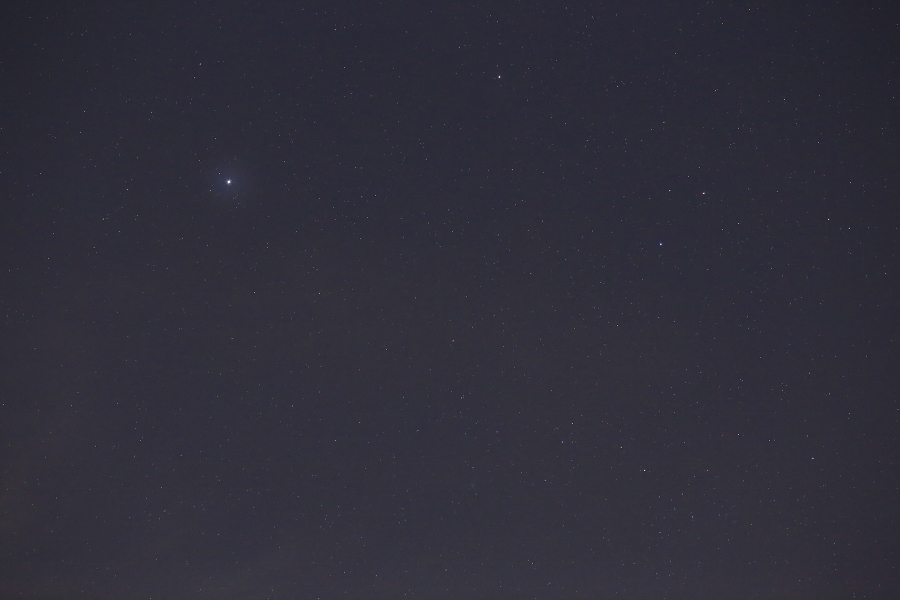
This image shows Comet 21P/Giacobini-Zinner, captured on September 5, 2018, at 1:26 am EDT from Swede Run in Moorestown, NJ. It was taken with a Canon 6D digital SLR camera and a Canon 200 mm f/2.8L telephoto lens (on a fixed tripod). Exposed 2 seconds at f/4, ISO 5000, 3800K white balance. Except for size reduction, no processing was applied. Mouseover for labels; the image below is a magnifying crop of the comet area.
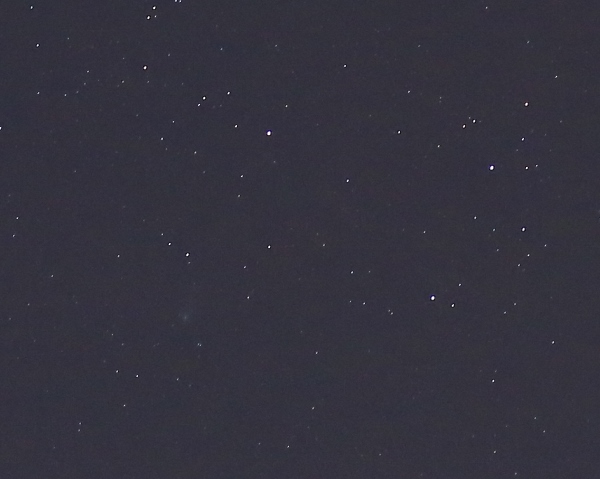
This is the same original image as above, but cropped to about a fifth of the original linear dimensions for a field 2.0° wide x 1.6° high (originally 10.2° x 6.8°). It may be my imagination, but there seems to be a vague tail extending towards Rho Aur (≈ west). At the time, the coma and Rho were about 42 arc minutes apart. Except for cropping and size reduction, it's unprocessed. Mouseover for labels.
I've been following this comet since August 4, 2018, when I initially saw it with 15x56 binoculars at Batsto in Wharton State Forest, NJ. I last saw the comet on September 4 around 5:15 am EDT at Swede Run (where astronomical twilight began at 4:56 am). Auriga was high overhead in a clear sky (foggy near the ground), but there was a 36% illuminated moon 24° away in Orion close to the border with Gemini. Regardless, I saw 21P with relative ease in the 15x56s.
On the morning of September 5, I wanted to beat moon rise at 1:34 am, so I was at Swede Run looking (and taking pictures) between about 1:00 and 1:30 am. The sky was generally hazy and there were streaky clouds lower in the sky in front of Auriga (the comet was about 25° altitude). As a result, I could not convincingly see 21P in the 15x56s.
Bob King has an online article at Sky & Telescope about observing 21P/Giacobini-Zinner in September 2018.
Finally, just before 1 am EDT on September 5, I saw a fireball from Swede Run and then submitted a report to the American Meteor Society. Here's the AMS summary page for that event.
Click here for the previous page.
Click here for an index to previous SJAstro pages.
